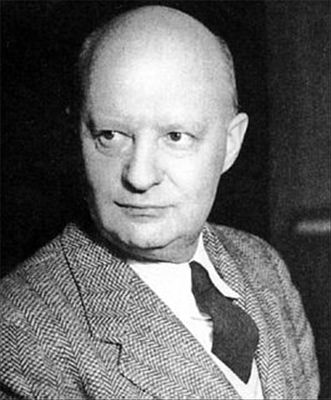Paul Hindemith
(1895-1963)
 Paul Hindemith was influential to the musical world, serving as a composer, violinist, violist, conductor, theorist and teacher throughout his lifetime.
Paul Hindemith was influential to the musical world, serving as a composer, violinist, violist, conductor, theorist and teacher throughout his lifetime.
Born in Germany, he learned violin as a child and began studying the instrument professionally while also taking lessons in conducting and composition. In 1914, he became the deputy leader of the Frankfurt Opera Orchestra. He played in string quartets and eventually founded his own, which toured several times throughout Europe.
He first gained attention in 1922, when some of his early compositions were played at the International Society for Contemporary Music. The following year he worked for another music festival and programmed pieces of avant garde composers like Schoenberg and Webern. Beginning in 1927, he started teaching composition at a music school in Berlin. During the 1930s he began travelling to Ankara (where he had the task of reorganizing Turkish music education) and to America as a soloist in frequent demand.
There was a fair amount of controversy surrounding Hindemith throughout his life, but especially during the 1930’s, when he would constantly be in and out of favor with the Nazi hierarchy. Finally, he and his wife made the decision to immigrate to Switzerland in 1938. After only a year, the couple left and immigrated to the United States. Once he arrived, he began teaching at Yale and had several notable students, including Norman Dello Joio. He obtained citizenship in 1946, but moved back to Europe in 1953, where he continued to teach.
Suffering through poor health during the end of his life, Hindemith continued to compose up until his death at the age of 68 from pancreatitis.
A significant German composer of his time, his works transcend many boundaries and include elements of romanticism, expressionism, and neoclassicism. Using a musical system that is tonal but non-diatonic, Hindemith used all 12 notes freely rather than selecting a scalar subset of notes. He favored this idea so much that he went back to some of his earlier works to revise them and implement this system. Another element in his compositional style is his ranking of intervals from the most consonant to the most dissonant. However, Hindemith does maintain the idea of a dissonance resolving to a consonance—for example, much of his music will begin in consonance, transition into dissonance, and resolve into full consonance at the end. Remembered for his contributions to the musical world and as an advocate for non-traditional compositional techniques, Hindemith’s works remain popular and well-known to this day.
Click below to view Paul Hindemith titles:
t7t3l0uhl8|0010C39D6D07|DetailContent|contenttext|566C7645-FB15-4E50-BEBF-CD75D331D719
<